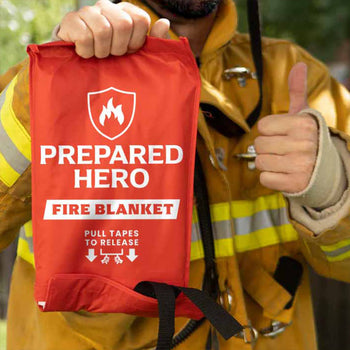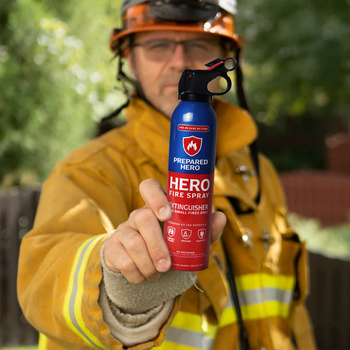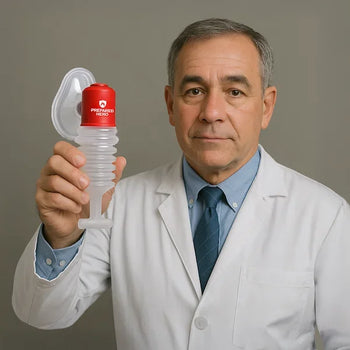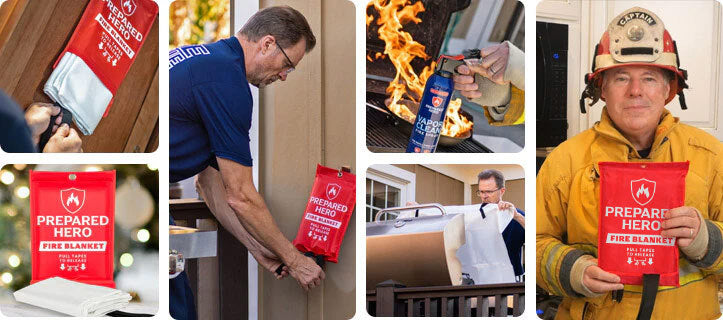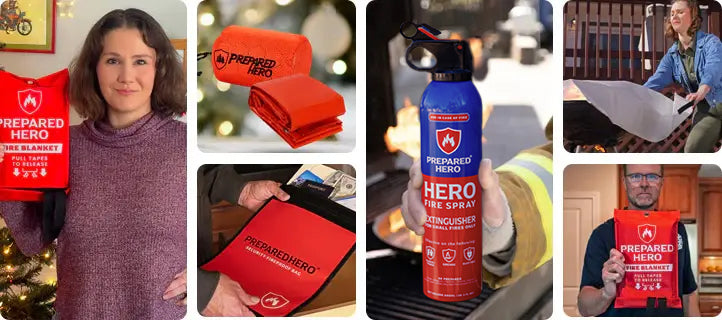Where you put your smoke detectors matters just as much as installing them. Proper placement makes sure they can detect...
According to the US Fire Administration (USFA), cooking is the number one cause of home fires and home fire injuries. Fire departments responded to about 170,000 home cooking fires in a year, which resulted in 135 deaths, 3,000 injuries, and more than $494 million in property loss.
Whether you're preparing a meal or whipping up a quick snack, cooking safely can help keep your loved ones and property safe. Unfortunately, not everyone knows about kitchen fire safety and how to implement safe practices. If you’re one of them, we’re here to help. This guide explains everything you need to know about kitchen fire safety so you can cook without worries.
Common Causes of Kitchen Fires

Cooking is an amazing activity, but it comes with some risks. When you preheat your oven or turn on your stove, there’s always a chance a fire could break out. Hence, you should understand the causes of kitchen fires. Let’s go over them below:
Unattended Cooking
According to a report by the USFA, unattended cooking is the top cause of home cooking fires (37%). Leaving kitchen appliances unattended, even for a few seconds, can cause a fire. Remember, fire can spread in as fast as 30 seconds, so that Thanksgiving turkey can quickly turn into an inferno.
It’s not a great idea to multi-task no matter how busy you are if there’s heat involved. Always focus on your cooking, and if you feel tired or sick, leave the kitchen alone and get takeout. In fact, more than one-quarter of people killed by cooking fires were asleep.
But if you need to leave the kitchen while cooking, we recommend asking someone else to watch the stove or oven. You can also set a timer to signal when the dish is cooked. However, it’s not safe to do this when you’re frying food.
High Cooking Temperatures
A high cooking temperature is another common cause of kitchen fires. While many think that turning the oven or stove all the way up cooks better, it doesn’t. You’ll just end up with burnt food or a fire if you do this. High heat also reduces the nutrients in many food items, including meat and vegetables.
Remember, fires start when the temperature is too high. If you see any smoke or burning food, turn off the heat source immediately.
Frying With Oil
Frying is more risky than other types of cooking since it involves using huge amounts of combustible cooking oil. However, many people, including experienced cooks, don’t realize that deep-frying is dangerous. For instance, olive oil has a flashpoint of 210°C (410°F). If it burns, you’re dealing with an intense fire.
Water also makes oil or grease fires worse because oil and water don’t mix. Water pushes the oil out, causing it to splatter and explode. It also makes the oil spread easily by making it airborne.
Flammable Items
There’s a fire hazard at almost every corner of your home. Most of them are in your kitchen, including napkins, rags, and boxes. If any of these flammable items go near heat sources like your stove and oven, a fire might start. The more flammable items near heat sources, the higher the fire risk.
Loose Clothes
Loose-fitting clothes can easily catch fire if they go near heat sources. Cotton and linen ignite quickly, so it’s best not to wear them (or at least the loose ones) when cooking. Polyester and nylon don’t ignite as quickly, but They can directly melt onto your skin and cause permanent damage. Remember, the best things to wear when cooking are form-fitting clothes and fire-retardant aprons.
How to Prevent Kitchen Fires
- Keep your kitchen clean: Cooking leads to leftover food and grease buildup, which quickly catches fire.
- Watch what you're cooking: Never leave your cooking unattended. If you need to leave, ask someone else to take over.
- Install smoke detectors and fire sprinklers: Place a smoke alarm and fire sprinkler inside or just outside your kitchen.
- Keep your kids away from the kitchen: Kids are naturally curious, so they’re more prone to kitchen accidents.
- Put flammable items away from heat sources: Don’t put flammable items, especially paper towels, rags, and boxes, near heat sources.
- Have a fire extinguisher or fire spray on standby: Place your fire spray or extinguisher in an accessible spot.
- Don't overheat oil: Always be aware of the oil’s temperature when you’re cooking with it.
Check out a more detailed guide to preventing kitchen fires here.
Kitchen Fire Safety Tools
Having the right fire prevention tools keeps your kitchen safe. Here are the kitchen fire safety tools you should have:
Fire Blanket

A fire blanket is a safety tool made of fire-resistant materials like fiberglass, silicone, and aramid fibers. They can withstand extremely high temperatures long enough to put a fire out. You can reuse fire blankets like the Hero Fire Blanket if they’re not damaged after use. On the other hand, most fire blankets can’t be reused and should be thrown away after one use.
They’re also among the best tools to have in your kitchen because fire blankets work on grease fires. Since you can’t use water to put out grease fires, using something that can protect you from oil splashes helps.
You see, fire blankets work by depleting the fire’s oxygen supply. By removing the oxygen from the equation, the fire blanket disrupts the fire triangle and extinguishes the fire.
Oxygen is also the easiest component to remove. Fire blankets take advantage of this. Since they’re made of fire-resistant materials, they can last long enough to remove the oxygen without burning.
There are five main types of fire blankets: fiberglass, cotton, wool, silicone, and hybrid. Each has unique features that make them the best choice. For example, if you're a homeowner who wants to protect your family from fires, you can use fiberglass or hybrid blankets. On the other hand, if you work in an industrial setting, we suggest using extra large fiberglass fire blankets.
Check out this guide for more in-depth answers to, “What is a fire blanket?”.
Fire Spray

A fire spray is another fire safety tool worth including in your kitchen fire safety kit. It extinguishes small fires before they turn into raging infernos. It’s also lightweight, non-toxic, and eco-friendly. Plus, it leaves less residue than fire extinguishers and is ideal for small apartments and car emergency kits.
Fire sprays work by covering the burning material and smothering the fire. Covering the burning material with a fire extinguishing agent cools down the fire and eventually removes heat from the fire triangle. Meanwhile, smothering the fire depletes it of oxygen, another element of the fire triangle.
It’s also easier to use a fire spray than a fire extinguisher because it doesn’t require training. Just tear the tab or pull the safety pin, aim at the base of the fire, and spray from side to side. Get more information on how to use a fire spray with this guide.
If you used a fire spray but didn’t empty it, spray all of its content to avoid the embers or hot spots from reigniting. Aim at the base of the fire and spray until the container is empty. Find out how to dispose of used fire sprays here.
Fire Extinguisher

A fire extinguisher is like a bigger, heavier version of a fire spray. However, they are more difficult to use because they contain more and usually involve chemicals that might harm people’s health. For instance, workplaces require employees to at least master the PASS fire extinguisher protocol before being allowed to use one.
While fire extinguishers are not the best in weight and flexibility, they’re must-haves in kitchens. When placed in the right locations, they can put out kitchen fires before the firefighters arrive or reduce the fire’s intensity as you evacuate your house. Find out where to put your kitchen fire extinguisher here.
While fire extinguishers are helpful, you have to be careful with them. Make sure to use the right fire extinguisher type when putting out a fire. Using the wrong one might lead to disaster. For instance, using a water or water mist fire extinguisher on a grease fire will make it worse.
Kitchen Fire Suppression System

A kitchen fire suppression system is particularly useful in places where a lot of cooking happens. Think about restaurants, food factories, and the like.
It usually acts as the first line of defense against kitchen fires. Experts usually install this system in the exhaust hood. In particular, a kitchen fire suppression system prevents fires from spreading to other areas.
Most kitchen fire suppression systems connect to the hood over your cooking area and the gas line running through the kitchen. The one in the hood cuts the fuel, while the other applies the chemical fire suppressant.
Fire Protection Gloves

Fire gloves protect your hands from extreme heat. They're made of fire-resistant materials like aramid fibers. These gloves are particularly helpful when you’re grilling. Charcoal can get extremely hot, and using protective gear is a must.
Additionally, fire protection gloves let you extinguish a fire without sustaining third or second-degree burns. For instance, you can wear fire protection gloves while using a fire blanket for maximum protection. Plus, they’re thick and long-lasting, making them a great long-term investment.
Smoke Alarm

Next on the list is a smoke alarm. Your kitchen needs at least one smoke alarm to let people know if there’s smoke. In particular, it detects smoke rising to the top and produces a sound to alert people. In addition, many advanced smoke alarms have sensors sensitive to smoke, heat, and the composition and density of fumes. Find out where to install smoke alarms here.
While smoke alarms can last for years, you need to clean, test, and replace them. Check out these guides for step-by-step instructions: how to clean your smoke alarm, how often to test your smoke alarm, and when to test your smoke alarm.
Fire Sprinkler

Fire sprinklers helped control 97% of fire incidents big enough to activate them, according to the National Fire Protection Association. They’re a must-have for any kitchen, especially in a huge home.
A fire sprinkler system contains four components: the water source, pipes, sprinkler riser, and head. The water source can be a water tank, municipal water system, or lake. The pipes connect the sprinkler to the water source, while the riser brings the water from the pipes to the overhead. Lastly, the sprinkler head releases water when the system detects fire. It’s the visible component usually installed on the ceiling.
How to Put Out a Kitchen Fire

Knowing how to put out a kitchen fire can help save lives and protect properties. Kitchen fires can spread fast, and having the right knowledge lets you act quickly and confidently. Here’s how to put out a kitchen fire based on where it started:
How to Put Out a Stove Fire
Here’s how to put out a stove fire:
1. Turn off the heat.
Turning off the heat should be your priority when a kitchen fire occurs. Doing so removes heat, which is one of the elements of the fire triangle. If you have time, wear fire protection gloves to protect your hands.
2. Cover the fire with a metal lid.
This only applies if you don’t have a fire blanket or fire spray. Otherwise, skip this step.
Covering the fire with a metal lid helps cut off its oxygen supply. If a metal lid isn’t available, you can use a cookie sheet or baking pan. Do not use glass or ceramic lids because they can shatter.
3. Use baking soda or salt.
This only applies if you don’t have a fire blanket or fire spray. Otherwise, skip this step.
Pouring baking soda or salt on the flames can help extinguish the fire because they deprive it of oxygen. But you have to use a lot of baking soda or salt. Remember not to use baking powder because it can make things worse.
4. Use a fire extinguisher as a last resort.
Using a fire extinguisher should be considered only after other methods have failed because it can create a toxic mess. But at the end of the day, a mess is better than a burned down house. Additionally, make sure you have the right type of fire extinguisher because some can make stove fires worse.
Check out this in-depth guide on how to put out a stove fire. It covers all the steps and tips for putting out stove fires quickly.
How to Put Out an Oven Fire
Here’s how to put out an oven fire:
1. Don’t open the oven.
Fire continues burning with oxygen. Opening your oven is dangerous and lets more oxygen in, which makes the fire bigger.
2. Turn off all heat and power sources.
Turn off or unplug the oven first. Then, turn off and unplug all nearby heat and power sources immediately. Doing these prevents the fire from spreading to areas outside your kitchen.
3. Use the right fire safety tools.
If grease or oil caused the oven fire, don’t use water or a water-based fire extinguisher to put it out. Use a fire spray or extinguisher made for grease fires instead.
4. Open the windows.
If the fire dies on its own or if you handled it by yourself, open the kitchen windows and doors. Doing this lets the smoke come out of your kitchen. Otherwise, proceed to the next step.
5. Call 911 if you can’t put out the fire.
If you can’t handle the fire on your own, evacuate your house immediately. Then, call the authorities.
Check out this in-depth guide on how to prevent and put out an oven fire. It covers all the steps and tips for putting out oven fires quickly. You can also check our guide on how to clean your oven to keep it fire-free.
Cooking Safety Tips

Keep your kitchen free from fire while you make your favorite meals with these top cooking safety tips:
- Never leave your kitchen unattended while cooking.
- Keep your kitchen clean and free of flammable materials.
- Clean up any spilled or splattered grease.
- Never throw hot grease in the garbage.
- Don't store anything in your oven.
- Turn the pot handles toward the back when you cook.
- Don't wear loose clothes while cooking.
- Don't cook if you're sleepy or drunk.
- Unplug or turn off appliances when not in use.
- Keep fire prevention tools nearby.
Find out how to use these cooking safety tips effectively here.
Common Myths About Kitchen Fires

Believing in kitchen fire myths can result in unsafe behaviors and increase the risk of fire-related accidents. Here are the top myths about kitchen fires you shouldn’t believe:
You can use water to put out a grease fire.
Water and oil don’t mix. When you pour water into burning oil, it can splatter and spread the fire, making the situation much worse. For these reasons, you should never use water to put out a grease fire. Instead, use a fire blanket or fire spray to put out the fire.
Fire extinguishers work on all fire types.
Not all fire extinguishers work on all fires. For instance, using a water-based fire extinguisher on a grease or electric fire can make it worse.
A smoke detector is enough for fire safety.
A smoke detector helps a lot, but it’s not enough. You need to have other fire safety tools, including fire sprays, fire blankets, fire protection gloves, and fire extinguishers, to keep everyone safe.
It's safe to leave the kitchen while cooking.
Unattended cooking is the top cause of cooking fires, according to the NFPA. Leaving the kitchen while cooking, even for a short time, can lead to accidents. Cooking requires your focus, especially with high-heat methods like frying.
Kitchen fires are rare.
Kitchen fires can happen anytime, anywhere. Please take kitchen fire safety seriously, regardless of how frequently you cook.
How Does a Grease Fire Start in the Kitchen?

Grease fires usually start in the kitchen when oil gets too hot, which can happen faster than you might think. When you heat oil, it reaches a boiling point. Once it starts boiling, trouble begins. For instance, if you crank up the heat too quickly or drop frozen food into hot oil, the moisture can cause the oil to smoke and potentially ignite.
Once the oil reaches its smoking point, it’s overheating. If you ignore the smoke and keep cooking, the oil can catch fire due to the vapor it releases. Grease fires are especially tricky because they can spread quickly and become hard to control, so keep an eye on your cooking and handle oil with care.
Can You Use Salt to Put Out a Kitchen Fire?

Yes, you can use salt to put out a kitchen fire. It can put out a small kitchen fire because it doesn’t burn, has a high melting point, and smothers the fire. However, you need a ton of salt to put out a fire. We recommend using a fire spray or fire blanket instead.
Find a more in-depth answer to, “Can you use salt to put out a kitchen fire?” here.
Can You Use Baking Soda to Put Out a Kitchen Fire?

Yes, you can use baking soda to put out a kitchen fire. It can put out a small kitchen fire because it’s not flammable, not combustible, and removes oxygen from the equation. You can find a more in-depth answer to, “Can you use baking soda to put out a kitchen fire?” here.
However, you need a ton of baking soda to put out a fire. Plus, the amount of baking soda people usually have in their kitchens is not enough to put out fires. We recommend using a fire spray or fire blanket instead. Check out why a fire blanket is better than baking soda here.
Can You Use a Glass Lid to Put Out a Kitchen Fire?
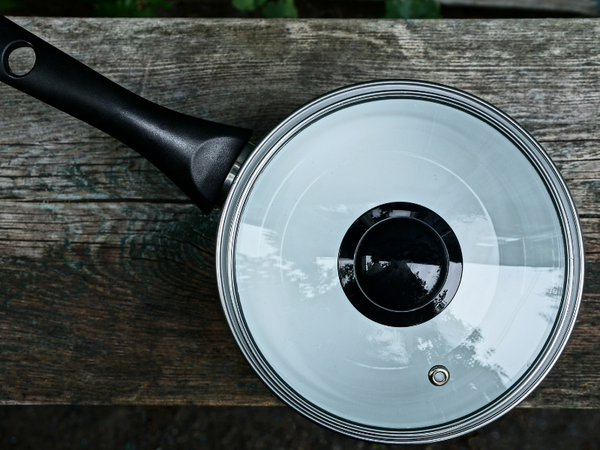
Yes, you can use a glass lid to put out a kitchen fire. It works by starving the fire of oxygen. You can find a more in-depth answer to, “Can you use a glass lid to put out a kitchen fire?” here.
However, using a glass lid has limitations and can be risky. A lid can only put out a kitchen fire if it’s in a container. It can only cover a small area, and the glass might explode if the fire gets too hot. Check out why a fire blanket is better than a lid here.
Can You Use a Wet Towel to Put Out a Kitchen Fire?

You can’t use a wet towel to put out a grease fire. Anything with water can make it worse. Plus, a wet towel can melt after it dries out. A fire blanket is a better choice for putting out kitchen fires quickly. Check out why a fire blanket is better than a wet towel here.
Conclusion
Staying safe in the kitchen is all about being aware and prepared. Kitchen fires can happen to anyone, but knowing how to prevent them and what to do if one breaks out makes a huge difference. By following the tips and understanding the myths above, you can cook with no worries. Stay safe, keep your fire safety tools handy, and happy cooking!


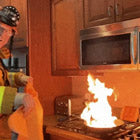 Fire
Fire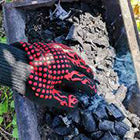 Safety
Safety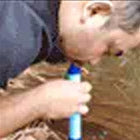 Survival
Survival Protection
Protection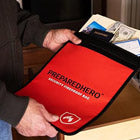 New
New Scouting America
Scouting America
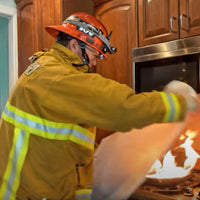 Fire
Fire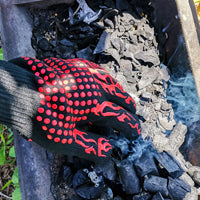 Safety
Safety Survival
Survival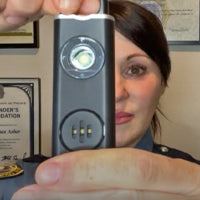 Protection
Protection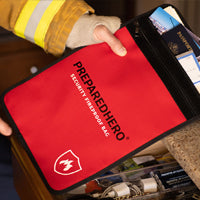 New
New
